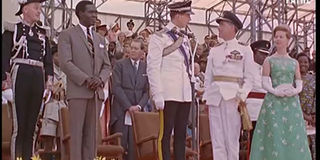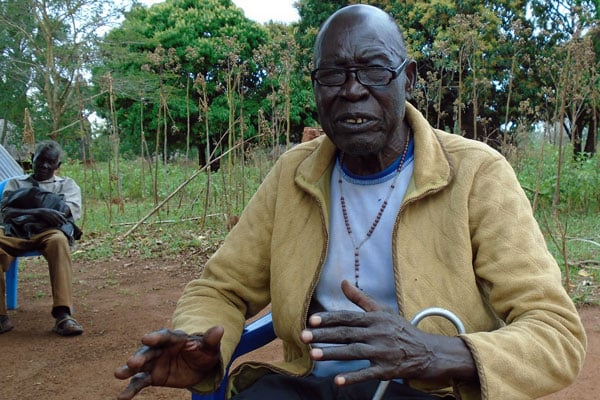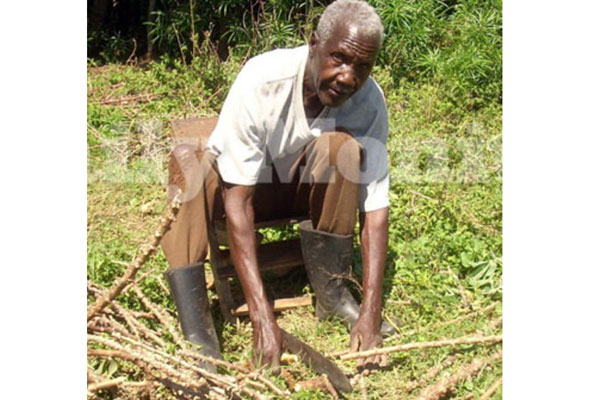Akorimo or Lawelo: Who actually raised Uganda’s flag at Independence?

An army officer believed to be Sgt Terencio Okello Lawelo raises the Uganda Flag on October 9, 1962. PHOTO/COURTESY/ JIMMY KWO/FILE
What you need to know:
- Whereas many Ugandans have been made to believe that Kanuti Akorimo, who hailed from Omatenga Village in Ongino, Kumi, raised the flag.
- Saturday Monitor’s inquiry into the mystery now reveals there is strong evidence pointing elsewhere that the person who could have performed that historic task has been quietly living in Kitgum District.
Do you remember the name Kanuti Akorimo and the story of Uganda’s Independence flag?
Indeed, nearly all Ugandans have been made to believe his unchallenged claims that he hoisted Uganda’s Independence flag at midnight on October 9, 1962.
But investigations by Saturday Monitor now point elsewhere to suggest that the ‘actual’ person who could have performed that historic task has been quietly living on the outskirts of Kitgum Municipality, Kitgum District.
Daily Monitor’s Canada-based weekly columnist, Dr Muniini K. Mulera, was the first to dismiss the claims that it was Akorimo who hoisted the flag as the clock struck midnight on the D-Day at Kololo Independence Grounds in Kampala.
“An impeccable source that was a member of the military at Independence assured me that Kanuti, a regimental sergeant major in the Uganda Rifles (as the army was known then), was nowhere near the flags at Kololo,” wrote Dr Muniini, in an October 9, 2018, opinion article ‘Myth and mystery about Uganda Flag on Independence Day’ published in Daily Monitor.
The third person
Before Akorimo came in the limelight, Dr Muniini wrote that another person was also touted to have had the honour to hoist the national flag.
“Few events have attracted as many falsehoods as the identity of the people who lowered the Union Jack and raised the Crested Crane,” he wrote.
“For years, the claim was that the historic act was performed by Lt Augustine “Gus” Karugaba. That was false. Karugaba, who never claimed that he hoisted our flag, repeatedly tried to set the record straight,” Dr Muniini wrote.
Referring to a BBC video recording of the time available on YouTube, Dr Muniini stated that the video shows the Union Jack being lowered by Sergeant Major Sidney Small of Birmingham, England.
“The Uganda flag is then hoisted by an African soldier of very dark complexion and average height, physical features that suggest that was not Kanuti. My source told me that Kanuti was tall and had a light complexion,” Dr Muniini further wrote.
“So, who hoisted the Uganda flag?” he wondered, before attempting to answer his own question: “We do not know at the moment. My source is confident that it was a darker skinned Acholi sergeant, who was a member of Company A or B, under the command of Maj Campbell,” he said.
Dr Muniini further wrote: “‘He was also a boxer, and I think he came from Kitgum’, my source told me.”
But for quite some time now, most media outlets have persisted that it was Akorimo who raised the Uganda Flag at Independence.

Left to right: Governor Sir Walter Coutts, prime minister Apollo Milton Obote, Duke of Kent Edward (centre), and Duchess of Kent Katharine (right) during celebrations to mark Uganda’s Independence at Kololo in Kampala on October 9, 1962. PHOTO/FILE/COURTESY
This misrepresentation has continued , even when the state-owned television station UTV (now UBC) ran for years video clips, every Independence period, showing a Whiteman lowering the Union Jack, the national flag of the United Kingdom, shortly after which a Black man raised Uganda’s national flag of black, yellow and red stripes.
“It bears repeating that journalists have a duty to exercise due diligence before publishing stories,” Dr Muniini lamented to that effect.
Dr Muniini further urged journalists and ‘military historians’ to use the available leads to help them “solve the mystery of the hero of our flag”.
“A great opportunity exists for an investigative journalist or a student reading history at one of Uganda’s universities to interrogate the government and military archives and set the record straight for posterity,” he appealed.
For Saturday Monitor, a deeper inquiry into the mystery of the hero who hoisted our Independence flag all started with a reminder in late 2018 by Mr Alexis Ocaya, the owner of Inland Restaurant in Kitgum Town, about Dr Muniini’s article.
Then a mid-2019 post by a London-based Facebook friend, Mr Richard Labongoweng Odongo, about his father’s boxing exploits with President Idi Amin, triggered more curiosity.
Mr Ocaya had then said he had heard of an elder in Kitgum, who had introduced another elder at a funeral as an ‘important person who had raised the Uganda flag at Independence on October 9, 1962.
I knew i had finally found the man I had been searching for all this while.
Discovering Terencio Okello Lawelo
On a fairly hot February 2020 afternoon, we set off for Pamolo on the outskirts of Kitgum Town to trace the man who we were told had played a significant role on Uganda’s Independence Day. I tagged along with a video documentary crew from the National Memory and Peace Documentation Centre in Kitgum, a national collaboration between Refugee Law Project and Kitgum District Local Government.
As we drove, I kept in constant phone contact for direction with Richard, his London-based son, who had visited home around the same time.
Terencio Okello Lawelo had already attained the rank of a sergeant when Uganda attained Independence in 1962. Even though it was over half a century ago, the 94-year-old still vividly recalls some minute details of key events leading up to Uganda independence.

Terencio Okello Lawelo during the interview at his home at Olet Village in Pamolo Parish, Labongo-Layamo Sub-county in Kitgum District, on February 5, 2020. PHOTO/FILE
About that time, Dr Muniini, in another October 15, 2019 Daily Monitor article, Shortcut journalism and Akorimo Kanuti’s fiction about Independence,’ writes that Mr Iain MacLeod, then British secretary for the colonies, ignoring the opinions of colonial officials in Uganda and Kenya, arbitrarily announced on October 9, 1961, that Uganda would gain self-governance on March 1, 1962, and full Independence on October 9, 1962.
Following that announcement, Lawelo learnt that instructions were later given to the Ministry of Defence to pass the message onto the first Ugandan army commander, Brig Shaban Opolot, to spearhead the search for a military officer to hoist the Uganda Flag on Independence Day.
The instructions were specific; the said officer should be at the rank of a sergeant and must be disciplined and smart. Lawelo was then under D Coy [Company D], commanded by a British officer based at now Gaddafi Barracks in Jinja.
“The army commander then [Brig Shaban Opolot] said: ‘Terencio, you have been selected to raise the flag,’” Lawelo reminisces as he beams with a broad smile.
But before the D-Day, Sgt Lawelo had to first be taken through drills of raising and lowering the flag.
“The training wasn’t hard. They blow buruji [the bugle] all through as you hoist the flag. Not that it took months, no. The rehearsals were brief,” he says.
Lawelo recalls that the Uganda flag was then kept neatly folded in a box at the barracks. “You carried it on your chest as though it were a delicate baby, while standing. You are not allowed to sit with it. There’s no rest,” he recalls.
On the eve of independence, Lawelo says still cuddling the flag like a baby, a heavy convoy of vehicles escorting the flag, left Jinja in the morning and proceeded to Entebbe, which was still the Capital City of Uganda. He says they camped in Entebbe with the flag until around 11.30pm when they left for Kololo Independence Grounds in Kampala to usher in Uganda’s Independence at midnight, October 9, 1962.
“When the flag was being taken to Kololo, I also carried it on my chest like a baby, with full military escorts in vehicles on October 9, 1962,” he reminisces.
As the clock struck midnight, Sgt Maj Sidney Small lowered the Union Jack, while Sgt Lawelo, whose army number he recalls was UO168, swears he hoisted the Uganda flag.
“The British flag was brought down and moments later, I raised the Uganda flag. The person who raised the flag is right here,” he says with a trace of pride on his face as he straightens up and taps his chest with his index finger.
Asked how he felt after being chosen among his peers and to perform the monumental and historic task, Lawelo looks into space as if to recreate the momentous occasion. “I didn’t have any extraordinary feelings. I was exhilarated after completing the task that was assigned to me,” he says.

Kanuti Akorimo, who hailed from Omatenga Village in Ongino, died at 89 years at Atutur Hospital in Kumi in April 2020. PHOTO/FILE
When we conducted the first interview at his home at Olet Village in Pamolo Parish, Labongo-Layamo Sub-county in Kitgum District on February 5, 2020, Akorimo was still alive. I asked Lawelo if he knew of a soldier named Kanuti Akorimo.
He tilted his head upwards and stared into space, as if lost in deep thought, before responding moments later.
“Hmm, I had interacted with most soldiers, but I don’t recall that name. What tribe was he?” he asked me. To which I replied: “An Itesot from Kumi.”
“Ah, ah, I don’t recall him,” he says with finality, before adding: “That’s why I was saying earlier that it was me [who hoisted the flag]. There was no one else.”
Akorimo, who hailed from Omatenga Village in Ongino, died at 89 years at Atutur Hospital in Kumi in April 2020; two months after our first contact with Lawelo. Akorimo succumbed to respiratory pneumonia after he suffered stroke in August 2019, Dr Isaac Omare confirmed in a media interview.
Our attempt to verify Lawelo’s information, especially through army records, hit a dead, despite several attempts.
Defence and army spokesperson Brig Flavia Byekwaso, in response to the claims over who exactly raised the flag at independence and if the UPDF has records to that effect, said: “I don’t have any clue (on that) issue of independence. I have never followed it. I don’t know who hoisted (the flag), I don’t know the story. It’s something I’ve to enquire about; it needs time for us to check around.”
But she acknowledged it was possible that some of the past army records are no longer available, given all the regime changes since independence.
“Perhaps the documents are not there because with all the changes in Governments that have happened we may not be able to have all the documents intact.”
Brig Byekwaso directed Saturday Monitor to the National Records Centre and Archive at the Ministry of Public Service in Wandegeya, Kampala, which she said be having such information or documents.
But other military sources we talked to said the country’s original army records from colonial to post-colonial periods were destroyed in a mysterious fire that razed the army headquarters at Republic House [now Bulange] at Lubiri in Mengo in 1989.
But why did Lawelo and his immediate people, who were aware that he was the one who hoisted the Uganda flag on Independence Day keep quiet all this long?
Multiple family sources say the old man’s silence is locked up in the story of a sad military misadventure in the late 1980s. The sources intimated that Lawelo and the others were arrested and locked up in an isolation underground jail in an unmentioned location for up to 12 years. Visitors were reportedly not allowed to see them, except one family member allowed just one visit a year.
When I expressed interest to ask Lawelo about that narrative, the source warned: “He will not tell you anything about it. He does not like to talk about it. Their conditions in jail was not good; they were tortured.”
But Lawelo says his close relationship with the Uganda flag did not end with him hoisting it on October 9, 1962.
He says he continued bearing the flag during military parades, especially on big occasions.
He recalls there were always two flags at parades; the Uganda flag and a particular army unit flag. He was always the one, he says, entrusted with carrying the national flag while any other sergeant was chosen to hold the army unit flag.
“Anytime there was a parade, I would be the one carrying the Uganda flag, until I was promoted to the rank of Sergeant Major when it was relocated to another sergeant,” Lawelo says.
To get to this national stage and perform this singular historic duty, Lawelo had to overcome several obstacles that life had thrust across his path, including tender age, but he beat them with steely determination, dedication, discipline and focus.
About Brig Terencio Okello Lawelo
Background
● 1927: Born at Pamolo, Labongo-Layamo, Kitgum District
● 1935-1939: Studied at Kitgum Boys Primary School
● 1938: Baptized in the Roman Catholic faith
● 1953: Married first wife, Elizabetha Atim
Military trainings
● February 5, 1953: Enlisted in 4th (Uganda) Battalion, King’s African Rifles (KAR)
● 1953: Completed six months training at Nakuru, Kenya
● Trained in Administration and Command course at School of Infantry, Jinja
● 1973: Trained as Company Commander in Israel
● 1975: Trained as Battalion Commander in Ghana
● 1984: Trained as Brigade Commander with courses in Administration and planning in Tabora, Tanzania
Rising through the ranks
● 1953: Lance Corporal, Jinja
● 1954: Corporal, Jinja
● 1956: Sergeant, Jinja
● Sgt Major
● 1963: Captain, Kabamba
● 1973: Major, after training in Israel
● 1984: Lieutenant Colonel, Eastern Brigade Headquarters, Mbale
● 1985: Brigadier, Mbale
● 1987: Abducted by Holy Spirit Movement rebels of Alice Lakwena and forced to fight until her defeat at Magamaga, Jinja, in same year.
● 1987: Reported to NRA Barracks, Soroti
● 1989: Discharged from NRA
● 1989, arrested, charged in Court Martial and detained at Makindye Barracks, Kampala, for 11 years.
● 2001/2002: Retired from active service.
Background...Kanuti Akorimo’s claims
Kanuti Akorimo claimed in media reports that being one of the most educated officers in the army then, prime minister Apollo Milton Obote consulted him on a number of issues, including giving him the final decision on who should become army commander – a decision that allegedly pitted him against Idi Amin.
“‘Maj Akorimo, you will bring down the colonial flag and hoist the Uganda flag,’ Obote told me. I felt a huge responsibility at the moment, I was tensed,” he recalled.
“I just couldn’t believe it,” Akorimo, recounts to the New Vision in one of his interviews, as he reportedly faced the task of hoisting the flag.
And he claimed that just hours before the event, “the city was tensed, as some people thought the British would resist our independence, while Obote reportedly feared Amin would disrupt the function.
Daily Monitor’s Canada-based weekly columnist, Dr Muniini K. Mulera, again wrote in Daily Monitor of 2019 that Akorimo’s claim that Amin and Obote were at loggerheads on the eve of Independence is not supported by any evidence.
“In fact, Obote saved Amin’s skin when he rejected recommendations for his prosecution for mass murder shortly before Independence. A much relieved and grateful Amin would have had no reason to disrupt the Independence celebration,” Dr Muniini wrote.
Dr Muniini further states: “Whether Kanuti’s claims reflect a severe memory lapse or some deliberate attempt to deceive is not as serious as the shortcut journalism that recycles his fiction as fact. A vigorous search for the truth is the insurance against distortion of history.”
Akorimo attended a commercial course in Nairobi, Kenya, and later trained in a short service commission in Britain.
He also served as the chairperson of Kumi Association of Ex-servicemen.
Akorimo died on April 22, 2020, with URN reporting that more than 1,500 mourners, consisting of family, relatives, friends and some Kumi District officials, attended the burial, defying then presidential directives limiting the number of mourners to just 20 due to Covid-19.
Akorimo, 89, left behind a widow, Florence Agwang, and 13 children.
More in Sunday Monitor (October 10, 2021) on ‘Brig Okello Lawelo: Joining KAR, boxing with Idi Amin, and escaping death squads.


